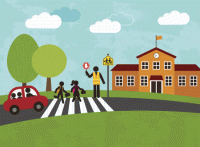The Principal Rule: Safety First
I had a conversation a few months ago with a parent about being a school principal. We were talking about the various demands of the job, from the different constituents that a school principal has to work with to the environment of a school. The parent asked me how I would define the job if I had only one word to use.
The word I chose was safety. The parent expressed some surprise and intrigue at my answer. We proceeded to talk about safety on multiple levels, beginning with physical safety, moving to emotional safety and finishing with academic safety.
As we are all reeling from last month's tragic events in Connecticut, school principals across the country are wrestling with how to ensure student safety, allay parent fears and empower teachers to continue with the daily work of teaching and learning. It's not an easy job.
Three Kinds of Safety
The first and most fundamental place for principals to start is with physical safety. Schools need to get students in the door safely. They need to create safe on-campus spaces in classrooms, hallways, lunch rooms and outdoor areas by providing supervision and communicating clearly to students about staying in bounds while at school. Schools also need to make sure students get home safely, whether it's on the bus or through carpool pickup. Tight, carefully coordinated and practiced systems need to be in place for this to happen smoothly. Communication to parents about safety procedures and protocols lets families know that the school cares about and values the physical safety of its students.
The second element of safety involves emotional safety. Students need to feel they are in an environment that nurtures and preserves relationships among students and with teachers. Every child in a school should have at least one adult with whom he or she feels a connection, or the ability to reach out to in a time of need. This adult can be a teacher, staff member or coach, but the school has a responsibility and obligation to systematically make sure that each child feels that connection, something beyond relationships with his or her peers. And schools need to communicate the importance of that relationship to students and families.
The third component of safety centers on academic safety. Teachers inside their classrooms are advocates for student learning and are charged with providing students with the academic tools for success. Students must feel safe taking risks, asking questions and tackling challenge. Academic safety can come in the form of working with a student at recess, before or after school, or clarifying a question over email in a tone and manner that leaves the student feeling inspired and heard. Also, teachers can send the message that the struggle of learning is a key part of growth and progress so that students are prepared to work hard, put forth effort and persevere through challenges, all of which ensures academic safety.
What Students Need to Hear
Schools across the country are taking pause, reflecting and working to find the appropriate message to share with students, who need to hear from the adults. Schools also need to keep students in the learning routine and rhythm, and maintain focus on classes and schoolwork. Routine provides comfort in uncertain times.
Little did I know that a conversation with a parent that happened a while ago would prove to be so prescient and timely and serve to remind me of the importance of working with everyone in a school community to create, nurture and sustain physical, emotional and academic safety for children. The bottom line is that students need to know and hear that their schools care deeply about them, and are available to help, support and guide them each day.
